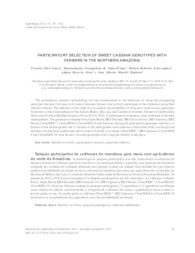Participatory selection of sweet cassava genotypes with Farmers in the northern Amazonia.
Participatory selection of sweet cassava genotypes with Farmers in the northern Amazonia.
Author(s): SOUZA, E. D.; LIMA, H. E. de; SCHWENGBER, D. R.; ALVES, A. B.; MATTIONI, J. A. M.
Summary: The participatory research methodology has been fundamental to the efficiency of using and propagating genotypes because it focuses on its main customers farmers who actively participate in the evaluation using their selection criteria. The objective of this study was to analyze the probability of using new sweet cassava genotypes by farmers in the municipalities of São João da Baliza, São Luiz, and Caroebe in Southern Territory of the Roraima State in the Northern Brazilian Amazon. From 2019 to 2020, 54 participatory evaluations were conducted in the three municipalities. The genotypes evaluated were Aipim Brasil, BRS Dourada, BRS Gema de Ovo, BRS Japonesa, BRS Moura, Clone RRM 7, Clone RRM 9, Clone RRM 10 and Saracura. During the participatory genotypes selection, 23 farmers of the female gender and 31 farmers of the male gender chose selection criteria like yield, root length and diameter, cooked pasta quality and starch content. Overall, on average, Clone RRM 7, BRS Japonesa, Clone RRM 9 and Clone RRM 10 were farmers? favorite genotypes with a high probability of adoption.
Publication year: 2022
Types of publication: Journal article
Unit: Embrapa Roraima
Observation
Some of Embrapa's publications are published as ePub files. To read them, use or download one of the following free software options to your computer or mobile device. Android: Google Play Books; IOS: iBooks; Windows and Linux: Calibre.
Access other publications
Access the Agricultural Research Database (BDPA) to consult Embrapa's full library collection and records.
Visit Embrapa Bookstore to purchase books and other publications sold by Embrapa.

